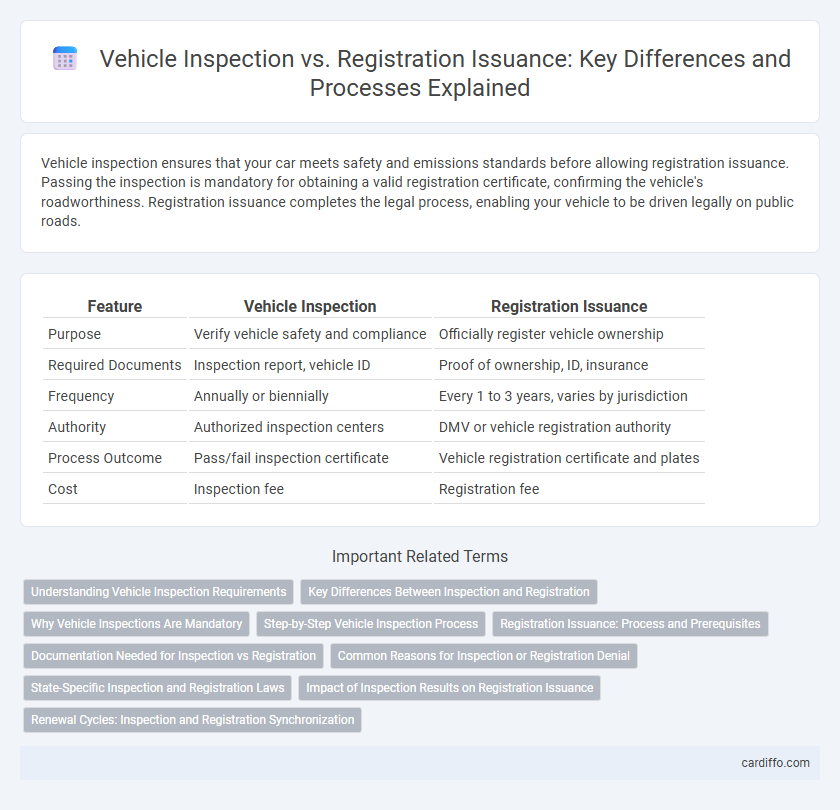Vehicle inspection ensures that your car meets safety and emissions standards before allowing registration issuance. Passing the inspection is mandatory for obtaining a valid registration certificate, confirming the vehicle's roadworthiness. Registration issuance completes the legal process, enabling your vehicle to be driven legally on public roads.
Table of Comparison
| Feature | Vehicle Inspection | Registration Issuance |
|---|---|---|
| Purpose | Verify vehicle safety and compliance | Officially register vehicle ownership |
| Required Documents | Inspection report, vehicle ID | Proof of ownership, ID, insurance |
| Frequency | Annually or biennially | Every 1 to 3 years, varies by jurisdiction |
| Authority | Authorized inspection centers | DMV or vehicle registration authority |
| Process Outcome | Pass/fail inspection certificate | Vehicle registration certificate and plates |
| Cost | Inspection fee | Registration fee |
Understanding Vehicle Inspection Requirements
Vehicle inspection requirements vary by jurisdiction and typically include emissions testing, safety checks, and verification of identification numbers to ensure compliance with state regulations. Passing a vehicle inspection is often mandatory before registration issuance, confirming that the vehicle meets safety and environmental standards. Understanding these requirements helps vehicle owners prepare necessary documentation and avoid delays during the registration process.
Key Differences Between Inspection and Registration
Vehicle inspection involves a thorough check of a vehicle's safety and emissions to ensure compliance with regulatory standards before use on public roads. Registration issuance is the formal process of recording vehicle ownership and granting legal permission to operate the vehicle, typically requiring proof of inspection, insurance, and payment of fees. The key differences lie in inspection being a mandatory safety and emissions evaluation, whereas registration is a legal authorization linked to ownership and operational legitimacy.
Why Vehicle Inspections Are Mandatory
Vehicle inspections are mandatory to ensure that all registered vehicles meet safety and environmental standards, reducing the risk of accidents and pollution. Inspections verify critical components such as brakes, lights, and emissions systems before registration issuance, protecting public health and road safety. Compliance with these inspection requirements is essential for legal vehicle registration and maintaining transportation infrastructure integrity.
Step-by-Step Vehicle Inspection Process
The vehicle inspection process involves a thorough evaluation of safety features, emissions, and mechanical condition to ensure compliance with regulatory standards. Technicians check critical components such as brakes, lights, tires, and exhaust systems during the inspection, documenting any deficiencies that must be addressed before registration issuance. Passing the inspection is mandatory for vehicle registration approval, linking roadworthiness directly to legal registration clearance.
Registration Issuance: Process and Prerequisites
Registration issuance requires verifying vehicle inspection compliance, ensuring all inspection certificates are valid and meet state safety and emissions standards. Applicants must provide proof of insurance, a completed application form, and payment of applicable fees to finalize the registration process. Once prerequisites are fulfilled, the motor vehicle department issues the registration documents and license plates, confirming legal permission to operate the vehicle.
Documentation Needed for Inspection vs Registration
Vehicle inspection requires documentation such as proof of insurance, a valid driver's license, and the vehicle's title or previous registration to verify ownership and compliance with safety and emissions standards. Registration issuance demands additional paperwork including a completed application form, proof of residency, and payment of registration fees, alongside the inspection certificate. Both processes prioritize accurate records but differ in specific documentation to ensure legal compliance and vehicle eligibility.
Common Reasons for Inspection or Registration Denial
Common reasons for vehicle inspection or registration denial include expired or missing emission test certificates, significant mechanical defects affecting safety, and outstanding recalls that remain unaddressed. Registration authorities often reject applications due to incomplete or incorrect documentation, unpaid fees, or outstanding fines related to the vehicle. Ensuring thorough compliance with safety standards and administrative requirements is crucial for successful vehicle registration and inspection approval.
State-Specific Inspection and Registration Laws
State-specific inspection and registration laws dictate that vehicles must pass mandatory safety and emissions inspections before registration issuance is granted. Inspection requirements vary significantly, with some states requiring annual inspections while others mandate them biannually or only upon initial registration. Compliance with these localized regulations ensures legal vehicle operation and prevents registration delays or penalties.
Impact of Inspection Results on Registration Issuance
Vehicle inspection results directly influence registration issuance by determining roadworthiness and compliance with safety standards; vehicles failing inspection are often denied registration until necessary repairs are completed. Authorization agencies use inspection data to prevent unsafe vehicles from being legally operated, thereby enhancing public safety and reducing accident risks. Timely resolution of inspection failures accelerates the registration process, ensuring vehicle owners meet legal requirements without unnecessary delays.
Renewal Cycles: Inspection and Registration Synchronization
Synchronizing vehicle inspection with registration renewal cycles streamlines compliance, reducing redundant visits and paperwork. Most jurisdictions mandate inspection validity to align with registration periods, typically annually or biennially, ensuring ongoing road safety. Efficient synchronization enhances governmental resource management and improves vehicle owner convenience by consolidating inspection and registration timelines.
Vehicle Inspection vs Registration Issuance Infographic

 cardiffo.com
cardiffo.com